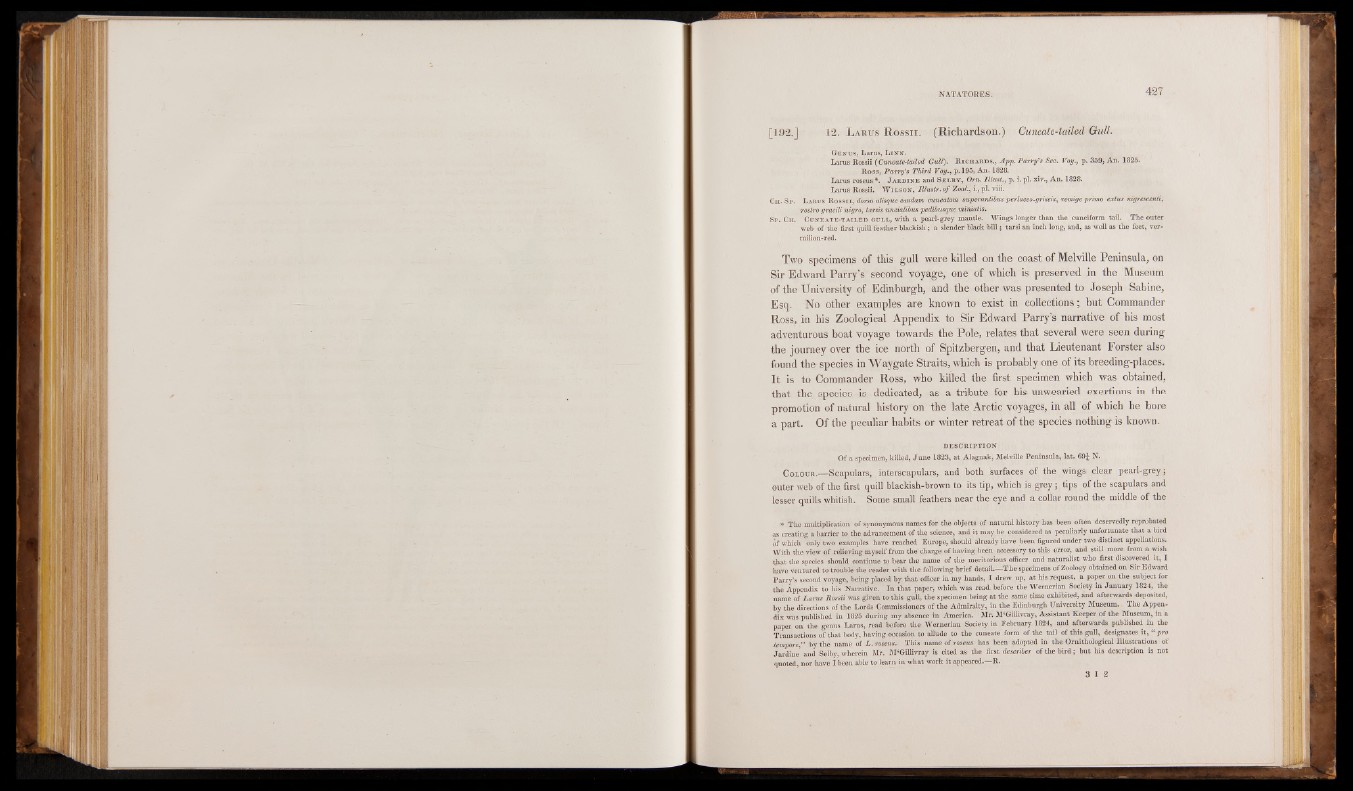
NATATORES. 427
[192.J ' 12. L a r u s R o s s i i . (Richardson.) Ouneate-tailed Gull.
Genus, Larus, Linn.
Larus Rossii (Cuneate-tailed Gull). Richards., App. Parry's Sec. Voy., p. 359, An. 1825.
Ross, Parry's Third Voy., p. 195, An. 1828.
Larus roseus*. J ardine and Selby, Ora. Illust., p. i. pi. xiv., An. 1828.
Larus Rossii. Wilson, Illustr.of Zool., i., pl. viii.
Ch . Sp. Larus Rossii, dorso alisque caudam ouneatam superantibus perlaceo-griseis, remige primo extus nigrescenli,
rostro gracili nigro, tar sis uncialibus pedibusque miniatis.
Sp. Ch. Cuneate-tailed gull, with a pearl-grey mantle. Wings longer than the cuneiform tail. The outer
web of the first quill feather blackish; a slender black bill; tarsi an inch long, and, as well as the feet, vermilion
red.
Two specimens of this gull were killed on the coast of Melville Peninsula, on
Sir Edward Parry’s second voyage, one of which is preserved in the Museum
of the University of Edinburgh, and the other was presented to Joseph Sabine,
Esq. No other examples are known to exist in collections; but Commander
Ross, in his Zoological Appendix to Sir Edward Parry’s narrative of his most
adventurous boat voyage towards the Pole, relates that several were seen during
the journey over the ioe north of Spitzbergen, and that Lieutenant Forster also
found the species in Waygate Straits, which is probably one of its breeding-places.
It is to Commander Ross, who killed the first specimen which was obtained,
that the species is dedicated, as a tribute for his unwearied exertions in the
promotion of natural history on the late Arctic voyages, in all of which he bore
a part. Of the peculiar habits or winter retreat of the species nothing is known.
DESCRIPTION
Of a specimen, killed, June 1823, at Alaguak, Melville Peninsula, lat. 69£ N.
C olour.—Scapulars, interscapulars, and both surfaces of the wings clear pearl-grey;
outer web of the first quill blackish-brown to its tip, which is grey;. tips of the scapulars and
lesser quills whitish. Some small feathers near the eye and a collar round the middle of the
* The multiplication of synonymous names for the objects of natural history has been often deservedly reprobated
as creating a barrier to the advancement of the science, and it may be considered as peculiarly unfortunate that a bird
of which only two examples have reached Europe, should already have been figured under two distinct appellations.
With the view of relieving myself from the charge of having been accessory to this error, and still more from a wish
that the species should continue to bear the name of the meritorious officer and naturalist who first discovered it, I
have ventured to trouble the reader with the following brief detail.—The specimens of Zoology obtained on Sir Edward
Parry’s second voyage, being placed by that officer in my hands, I drew up, at his request, a paper on the subject for
the Appendix to his Narrative. In that paper, which was read, before the Wernerian Society in January 1824, the
name of Larus Rossii was given to this gull, the specimen being at the same time exhibited, and afterwards deposited,
by the directions of the Lords Commissioners of the Admiralty, in the Edinburgh University Museum. The Appendix
was published in 1825 during my absence in America. Mr. M‘Gillivray, Assistant Keeper of the Museum, in a
paper on the genus Larus, read before the Wernerian Society in February 1824, and afterwards published in the
Transactions of that body, having occasion to allude to the cuneate form of the tail of this gull, designates it, “ pro
tempore,” by the name of L. roseus. This name of roseus has been adopted in the Ornithological Illustrations of
Jardine’ and Selby, wherein Mr. M‘Gillivray is cited as the first describer of the bird; but his description is not
quoted, nor have I been able to learn in what work it appeared. R.
3 12